Organisational Training Requirements for Tesco: A Detailed Analysis
VerifiedAdded on 2021/04/21
|10
|1839
|24
Report
AI Summary
This report analyzes the organizational training requirements for Tesco, a leading UK retail organization. It begins with an executive summary highlighting the importance of skills and knowledge in enhancing organizational strategy and adapting to environmental changes. The report identifies key problems such as poor customer service, language barriers, lack of commercial confidentiality, employee demotivation, and the sale of foreign brands. It then proposes solutions, including training in soft skills, local languages, analytical and problem-solving skills, and technology. The report details specific training requirements, emphasizing the importance of training management, including areas such as customer service, technical support, and organizational operation management. The report covers training methodologies, required resources, and methods for monitoring effectiveness, and concludes by stressing the importance of training programs in improving work performance, promoting organizational values, and achieving strategic goals. The report references various studies to support its findings.
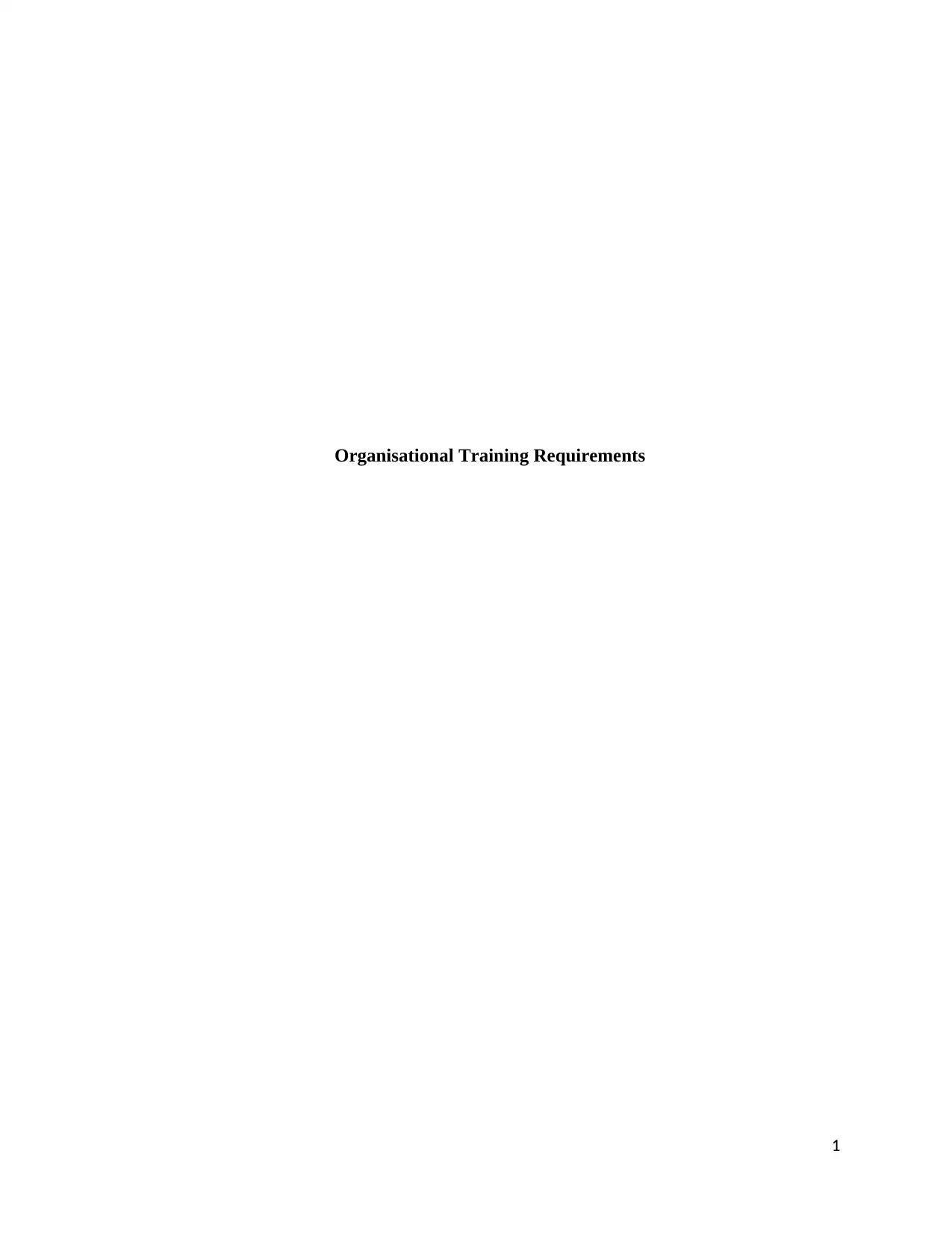
Organisational Training Requirements
1
1
Paraphrase This Document
Need a fresh take? Get an instant paraphrase of this document with our AI Paraphraser
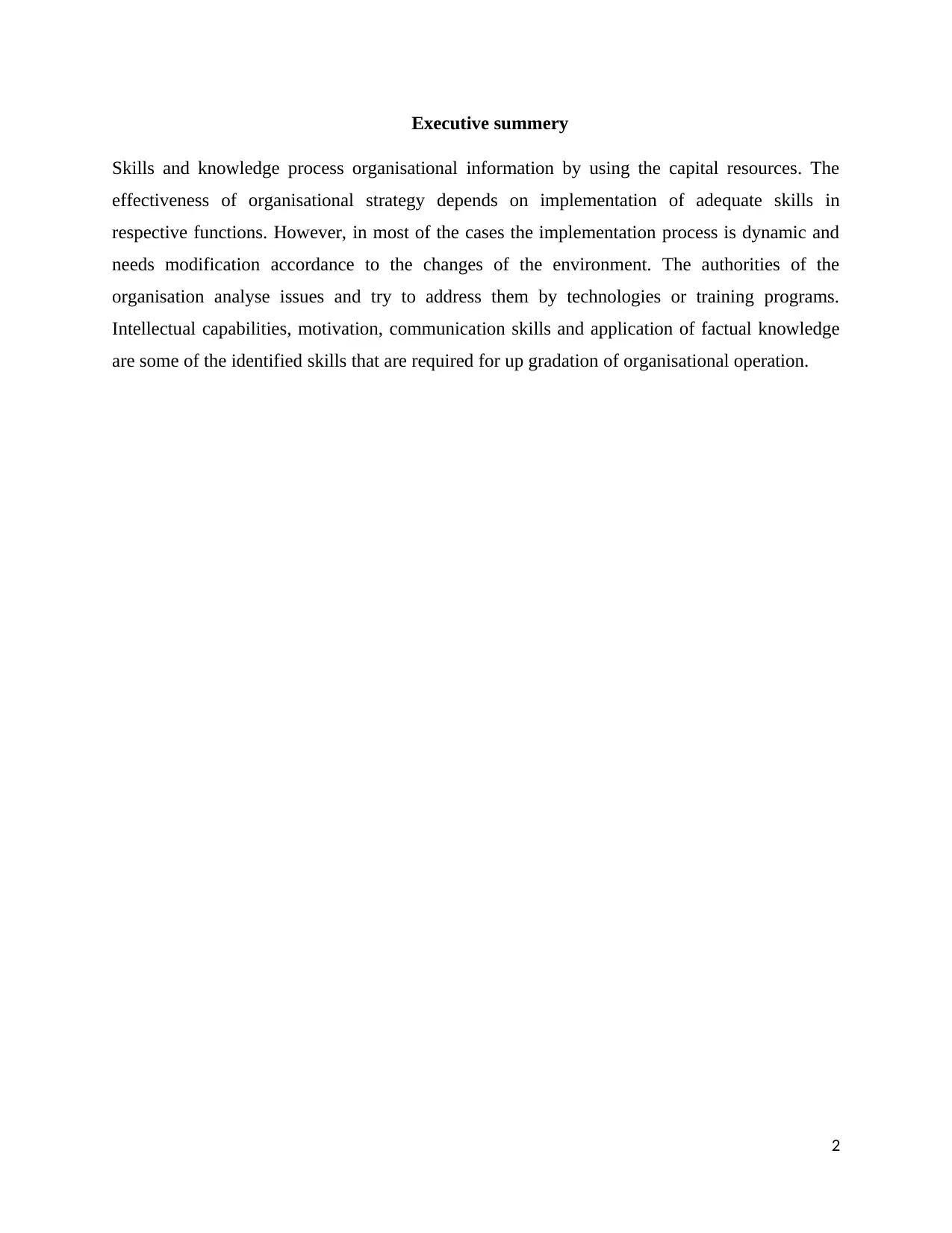
Executive summery
Skills and knowledge process organisational information by using the capital resources. The
effectiveness of organisational strategy depends on implementation of adequate skills in
respective functions. However, in most of the cases the implementation process is dynamic and
needs modification accordance to the changes of the environment. The authorities of the
organisation analyse issues and try to address them by technologies or training programs.
Intellectual capabilities, motivation, communication skills and application of factual knowledge
are some of the identified skills that are required for up gradation of organisational operation.
2
Skills and knowledge process organisational information by using the capital resources. The
effectiveness of organisational strategy depends on implementation of adequate skills in
respective functions. However, in most of the cases the implementation process is dynamic and
needs modification accordance to the changes of the environment. The authorities of the
organisation analyse issues and try to address them by technologies or training programs.
Intellectual capabilities, motivation, communication skills and application of factual knowledge
are some of the identified skills that are required for up gradation of organisational operation.
2
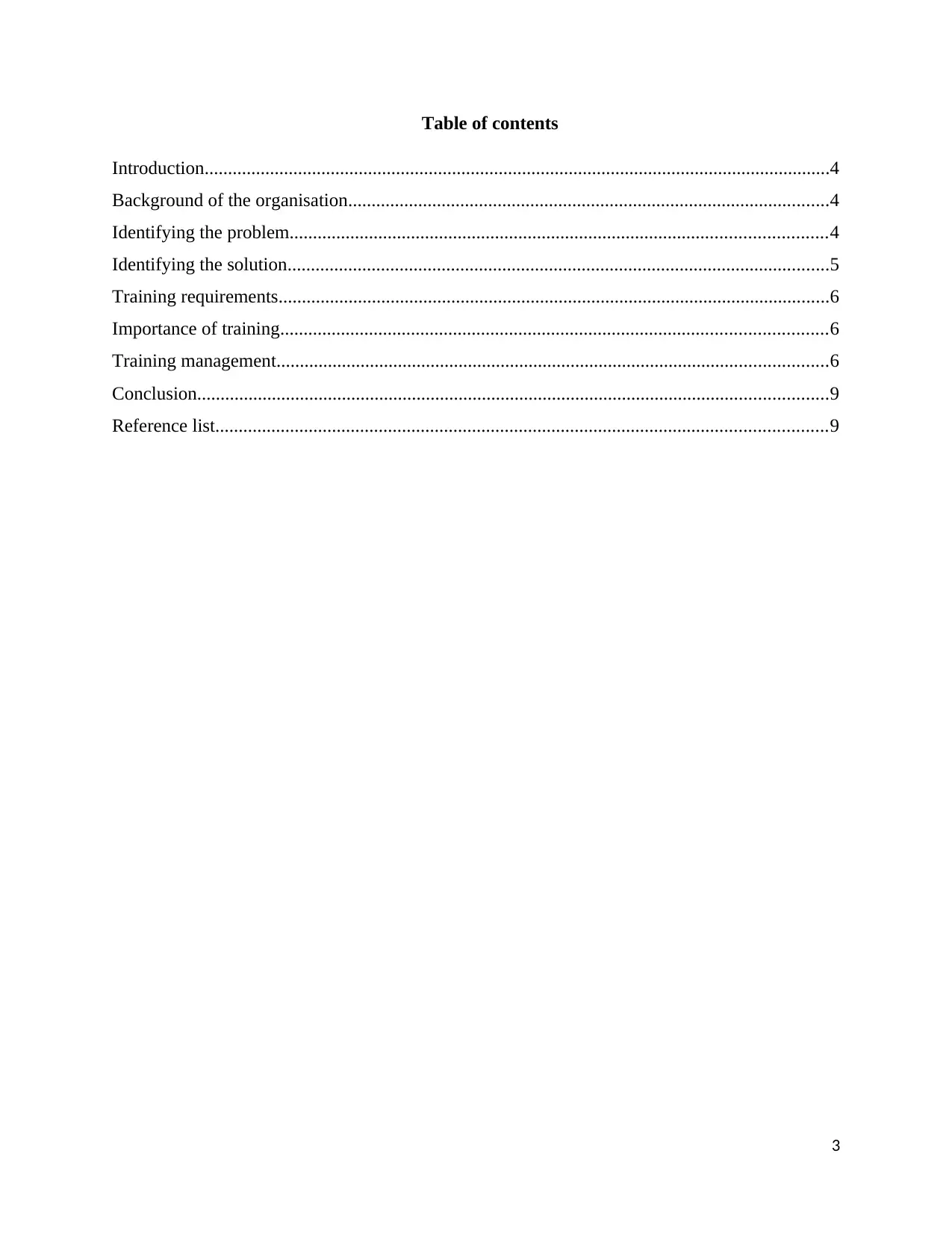
Table of contents
Introduction......................................................................................................................................4
Background of the organisation.......................................................................................................4
Identifying the problem...................................................................................................................4
Identifying the solution....................................................................................................................5
Training requirements......................................................................................................................6
Importance of training.....................................................................................................................6
Training management......................................................................................................................6
Conclusion.......................................................................................................................................9
Reference list...................................................................................................................................9
3
Introduction......................................................................................................................................4
Background of the organisation.......................................................................................................4
Identifying the problem...................................................................................................................4
Identifying the solution....................................................................................................................5
Training requirements......................................................................................................................6
Importance of training.....................................................................................................................6
Training management......................................................................................................................6
Conclusion.......................................................................................................................................9
Reference list...................................................................................................................................9
3
⊘ This is a preview!⊘
Do you want full access?
Subscribe today to unlock all pages.

Trusted by 1+ million students worldwide
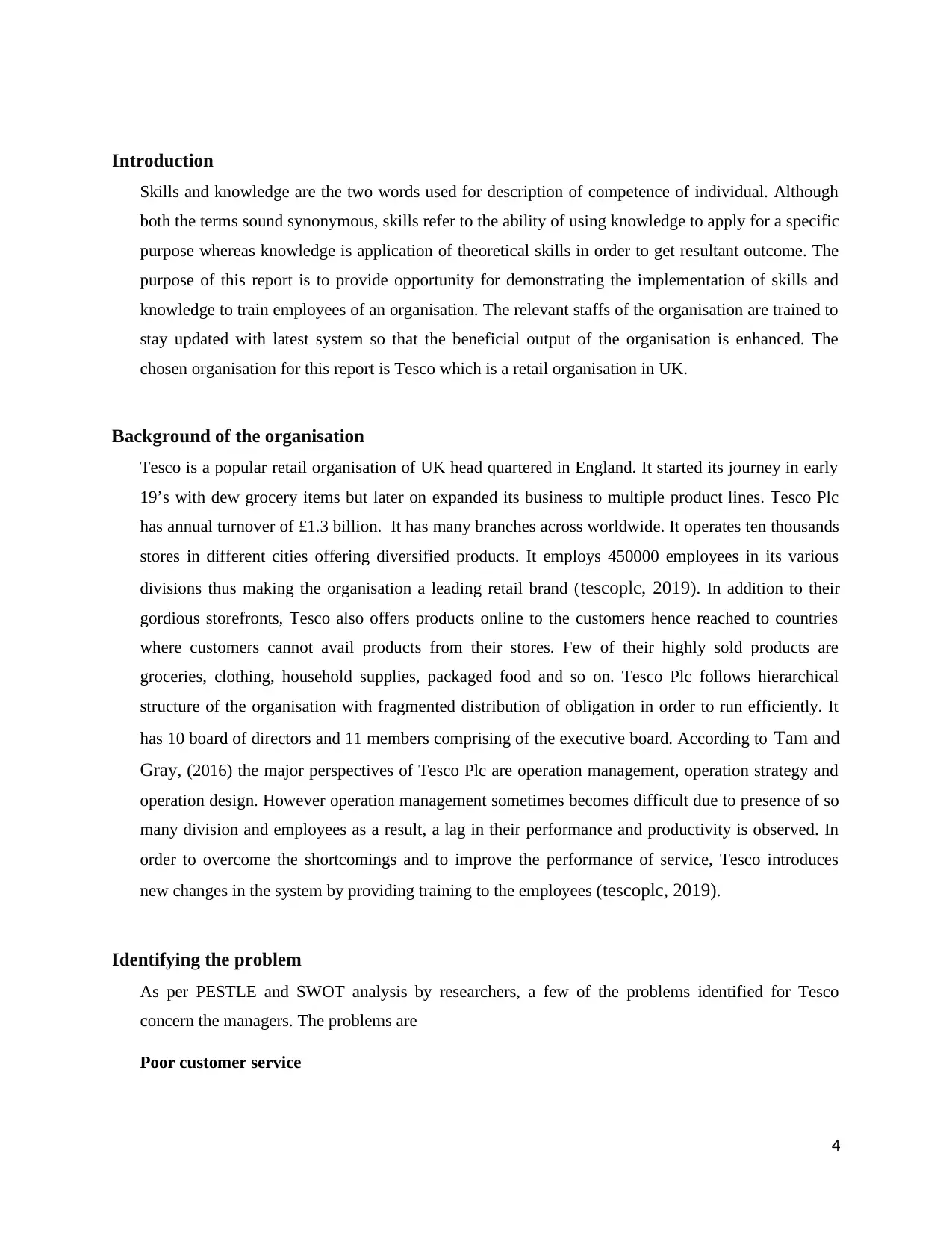
Introduction
Skills and knowledge are the two words used for description of competence of individual. Although
both the terms sound synonymous, skills refer to the ability of using knowledge to apply for a specific
purpose whereas knowledge is application of theoretical skills in order to get resultant outcome. The
purpose of this report is to provide opportunity for demonstrating the implementation of skills and
knowledge to train employees of an organisation. The relevant staffs of the organisation are trained to
stay updated with latest system so that the beneficial output of the organisation is enhanced. The
chosen organisation for this report is Tesco which is a retail organisation in UK.
Background of the organisation
Tesco is a popular retail organisation of UK head quartered in England. It started its journey in early
19’s with dew grocery items but later on expanded its business to multiple product lines. Tesco Plc
has annual turnover of £1.3 billion. It has many branches across worldwide. It operates ten thousands
stores in different cities offering diversified products. It employs 450000 employees in its various
divisions thus making the organisation a leading retail brand (tescoplc, 2019). In addition to their
gordious storefronts, Tesco also offers products online to the customers hence reached to countries
where customers cannot avail products from their stores. Few of their highly sold products are
groceries, clothing, household supplies, packaged food and so on. Tesco Plc follows hierarchical
structure of the organisation with fragmented distribution of obligation in order to run efficiently. It
has 10 board of directors and 11 members comprising of the executive board. According to Tam and
Gray, (2016) the major perspectives of Tesco Plc are operation management, operation strategy and
operation design. However operation management sometimes becomes difficult due to presence of so
many division and employees as a result, a lag in their performance and productivity is observed. In
order to overcome the shortcomings and to improve the performance of service, Tesco introduces
new changes in the system by providing training to the employees (tescoplc, 2019).
Identifying the problem
As per PESTLE and SWOT analysis by researchers, a few of the problems identified for Tesco
concern the managers. The problems are
Poor customer service
4
Skills and knowledge are the two words used for description of competence of individual. Although
both the terms sound synonymous, skills refer to the ability of using knowledge to apply for a specific
purpose whereas knowledge is application of theoretical skills in order to get resultant outcome. The
purpose of this report is to provide opportunity for demonstrating the implementation of skills and
knowledge to train employees of an organisation. The relevant staffs of the organisation are trained to
stay updated with latest system so that the beneficial output of the organisation is enhanced. The
chosen organisation for this report is Tesco which is a retail organisation in UK.
Background of the organisation
Tesco is a popular retail organisation of UK head quartered in England. It started its journey in early
19’s with dew grocery items but later on expanded its business to multiple product lines. Tesco Plc
has annual turnover of £1.3 billion. It has many branches across worldwide. It operates ten thousands
stores in different cities offering diversified products. It employs 450000 employees in its various
divisions thus making the organisation a leading retail brand (tescoplc, 2019). In addition to their
gordious storefronts, Tesco also offers products online to the customers hence reached to countries
where customers cannot avail products from their stores. Few of their highly sold products are
groceries, clothing, household supplies, packaged food and so on. Tesco Plc follows hierarchical
structure of the organisation with fragmented distribution of obligation in order to run efficiently. It
has 10 board of directors and 11 members comprising of the executive board. According to Tam and
Gray, (2016) the major perspectives of Tesco Plc are operation management, operation strategy and
operation design. However operation management sometimes becomes difficult due to presence of so
many division and employees as a result, a lag in their performance and productivity is observed. In
order to overcome the shortcomings and to improve the performance of service, Tesco introduces
new changes in the system by providing training to the employees (tescoplc, 2019).
Identifying the problem
As per PESTLE and SWOT analysis by researchers, a few of the problems identified for Tesco
concern the managers. The problems are
Poor customer service
4
Paraphrase This Document
Need a fresh take? Get an instant paraphrase of this document with our AI Paraphraser
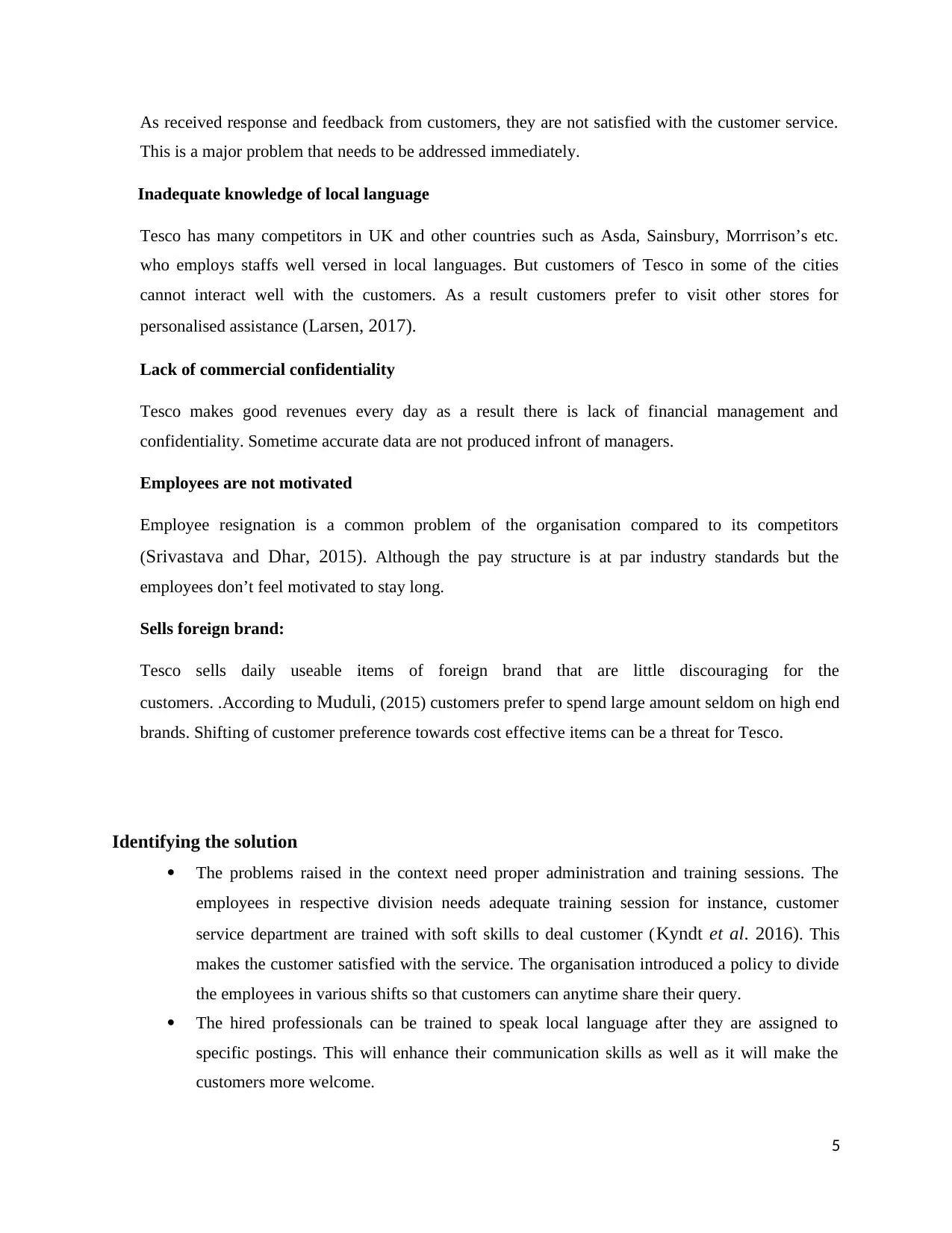
As received response and feedback from customers, they are not satisfied with the customer service.
This is a major problem that needs to be addressed immediately.
Inadequate knowledge of local language
Tesco has many competitors in UK and other countries such as Asda, Sainsbury, Morrrison’s etc.
who employs staffs well versed in local languages. But customers of Tesco in some of the cities
cannot interact well with the customers. As a result customers prefer to visit other stores for
personalised assistance (Larsen, 2017).
Lack of commercial confidentiality
Tesco makes good revenues every day as a result there is lack of financial management and
confidentiality. Sometime accurate data are not produced infront of managers.
Employees are not motivated
Employee resignation is a common problem of the organisation compared to its competitors
(Srivastava and Dhar, 2015). Although the pay structure is at par industry standards but the
employees don’t feel motivated to stay long.
Sells foreign brand:
Tesco sells daily useable items of foreign brand that are little discouraging for the
customers. .According to Muduli, (2015) customers prefer to spend large amount seldom on high end
brands. Shifting of customer preference towards cost effective items can be a threat for Tesco.
Identifying the solution
The problems raised in the context need proper administration and training sessions. The
employees in respective division needs adequate training session for instance, customer
service department are trained with soft skills to deal customer (Kyndt et al. 2016). This
makes the customer satisfied with the service. The organisation introduced a policy to divide
the employees in various shifts so that customers can anytime share their query.
The hired professionals can be trained to speak local language after they are assigned to
specific postings. This will enhance their communication skills as well as it will make the
customers more welcome.
5
This is a major problem that needs to be addressed immediately.
Inadequate knowledge of local language
Tesco has many competitors in UK and other countries such as Asda, Sainsbury, Morrrison’s etc.
who employs staffs well versed in local languages. But customers of Tesco in some of the cities
cannot interact well with the customers. As a result customers prefer to visit other stores for
personalised assistance (Larsen, 2017).
Lack of commercial confidentiality
Tesco makes good revenues every day as a result there is lack of financial management and
confidentiality. Sometime accurate data are not produced infront of managers.
Employees are not motivated
Employee resignation is a common problem of the organisation compared to its competitors
(Srivastava and Dhar, 2015). Although the pay structure is at par industry standards but the
employees don’t feel motivated to stay long.
Sells foreign brand:
Tesco sells daily useable items of foreign brand that are little discouraging for the
customers. .According to Muduli, (2015) customers prefer to spend large amount seldom on high end
brands. Shifting of customer preference towards cost effective items can be a threat for Tesco.
Identifying the solution
The problems raised in the context need proper administration and training sessions. The
employees in respective division needs adequate training session for instance, customer
service department are trained with soft skills to deal customer (Kyndt et al. 2016). This
makes the customer satisfied with the service. The organisation introduced a policy to divide
the employees in various shifts so that customers can anytime share their query.
The hired professionals can be trained to speak local language after they are assigned to
specific postings. This will enhance their communication skills as well as it will make the
customers more welcome.
5
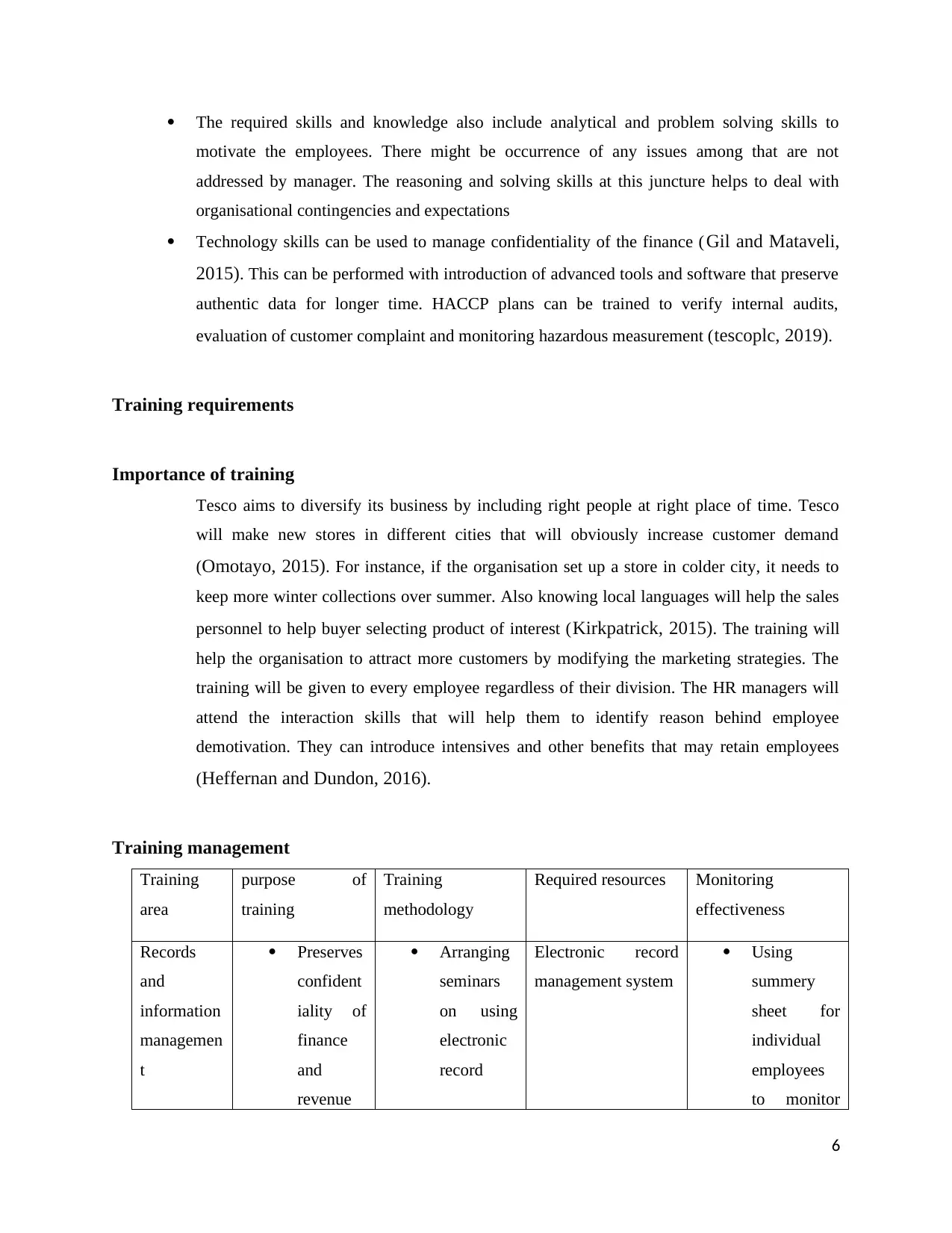
The required skills and knowledge also include analytical and problem solving skills to
motivate the employees. There might be occurrence of any issues among that are not
addressed by manager. The reasoning and solving skills at this juncture helps to deal with
organisational contingencies and expectations
Technology skills can be used to manage confidentiality of the finance ( Gil and Mataveli,
2015). This can be performed with introduction of advanced tools and software that preserve
authentic data for longer time. HACCP plans can be trained to verify internal audits,
evaluation of customer complaint and monitoring hazardous measurement (tescoplc, 2019).
Training requirements
Importance of training
Tesco aims to diversify its business by including right people at right place of time. Tesco
will make new stores in different cities that will obviously increase customer demand
(Omotayo, 2015). For instance, if the organisation set up a store in colder city, it needs to
keep more winter collections over summer. Also knowing local languages will help the sales
personnel to help buyer selecting product of interest (Kirkpatrick, 2015). The training will
help the organisation to attract more customers by modifying the marketing strategies. The
training will be given to every employee regardless of their division. The HR managers will
attend the interaction skills that will help them to identify reason behind employee
demotivation. They can introduce intensives and other benefits that may retain employees
(Heffernan and Dundon, 2016).
Training management
Training
area
purpose of
training
Training
methodology
Required resources Monitoring
effectiveness
Records
and
information
managemen
t
Preserves
confident
iality of
finance
and
revenue
Arranging
seminars
on using
electronic
record
Electronic record
management system
Using
summery
sheet for
individual
employees
to monitor
6
motivate the employees. There might be occurrence of any issues among that are not
addressed by manager. The reasoning and solving skills at this juncture helps to deal with
organisational contingencies and expectations
Technology skills can be used to manage confidentiality of the finance ( Gil and Mataveli,
2015). This can be performed with introduction of advanced tools and software that preserve
authentic data for longer time. HACCP plans can be trained to verify internal audits,
evaluation of customer complaint and monitoring hazardous measurement (tescoplc, 2019).
Training requirements
Importance of training
Tesco aims to diversify its business by including right people at right place of time. Tesco
will make new stores in different cities that will obviously increase customer demand
(Omotayo, 2015). For instance, if the organisation set up a store in colder city, it needs to
keep more winter collections over summer. Also knowing local languages will help the sales
personnel to help buyer selecting product of interest (Kirkpatrick, 2015). The training will
help the organisation to attract more customers by modifying the marketing strategies. The
training will be given to every employee regardless of their division. The HR managers will
attend the interaction skills that will help them to identify reason behind employee
demotivation. They can introduce intensives and other benefits that may retain employees
(Heffernan and Dundon, 2016).
Training management
Training
area
purpose of
training
Training
methodology
Required resources Monitoring
effectiveness
Records
and
information
managemen
t
Preserves
confident
iality of
finance
and
revenue
Arranging
seminars
on using
electronic
record
Electronic record
management system
Using
summery
sheet for
individual
employees
to monitor
6
⊘ This is a preview!⊘
Do you want full access?
Subscribe today to unlock all pages.

Trusted by 1+ million students worldwide
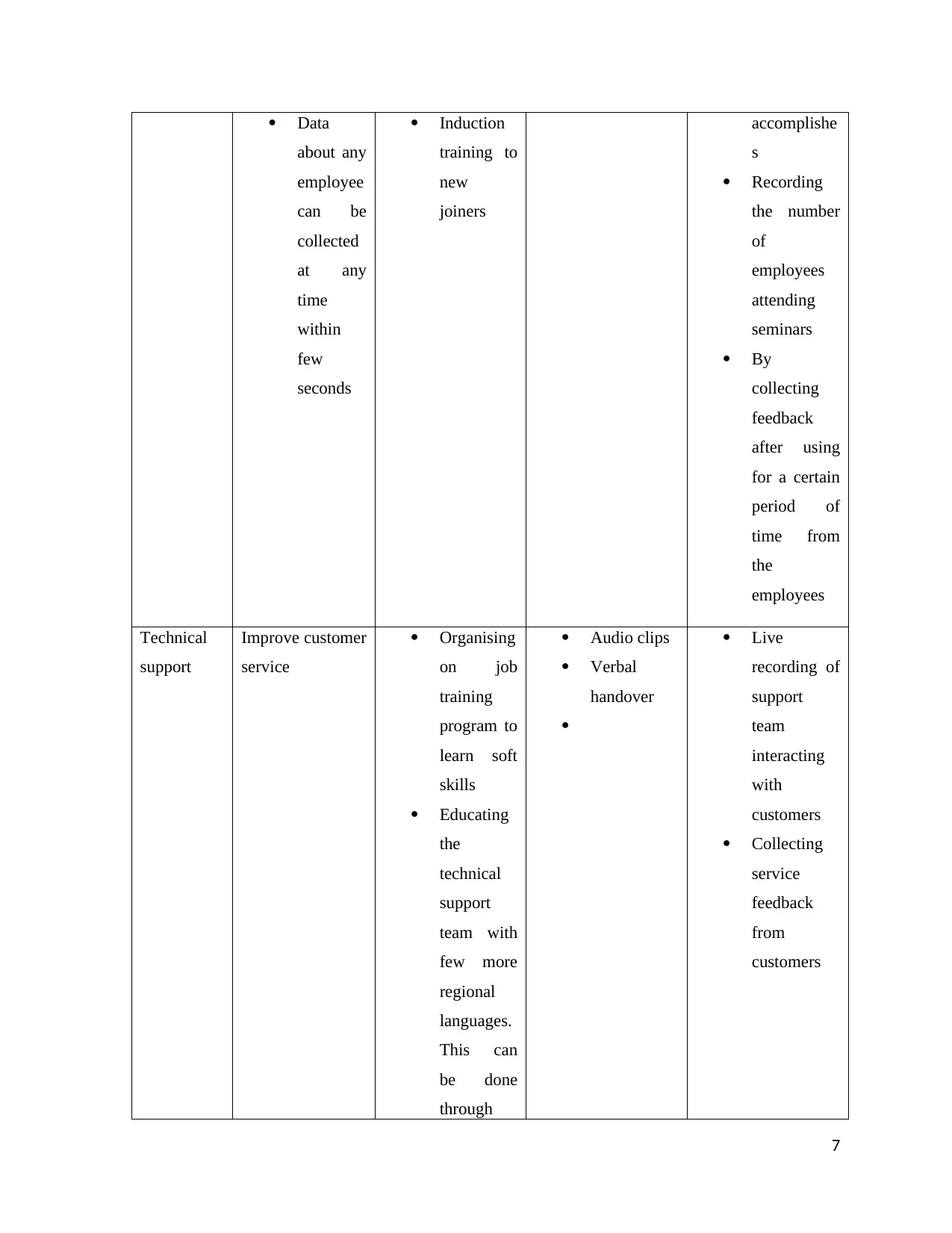
Data
about any
employee
can be
collected
at any
time
within
few
seconds
Induction
training to
new
joiners
accomplishe
s
Recording
the number
of
employees
attending
seminars
By
collecting
feedback
after using
for a certain
period of
time from
the
employees
Technical
support
Improve customer
service
Organising
on job
training
program to
learn soft
skills
Educating
the
technical
support
team with
few more
regional
languages.
This can
be done
through
Audio clips
Verbal
handover
Live
recording of
support
team
interacting
with
customers
Collecting
service
feedback
from
customers
7
about any
employee
can be
collected
at any
time
within
few
seconds
Induction
training to
new
joiners
accomplishe
s
Recording
the number
of
employees
attending
seminars
By
collecting
feedback
after using
for a certain
period of
time from
the
employees
Technical
support
Improve customer
service
Organising
on job
training
program to
learn soft
skills
Educating
the
technical
support
team with
few more
regional
languages.
This can
be done
through
Audio clips
Verbal
handover
Live
recording of
support
team
interacting
with
customers
Collecting
service
feedback
from
customers
7
Paraphrase This Document
Need a fresh take? Get an instant paraphrase of this document with our AI Paraphraser
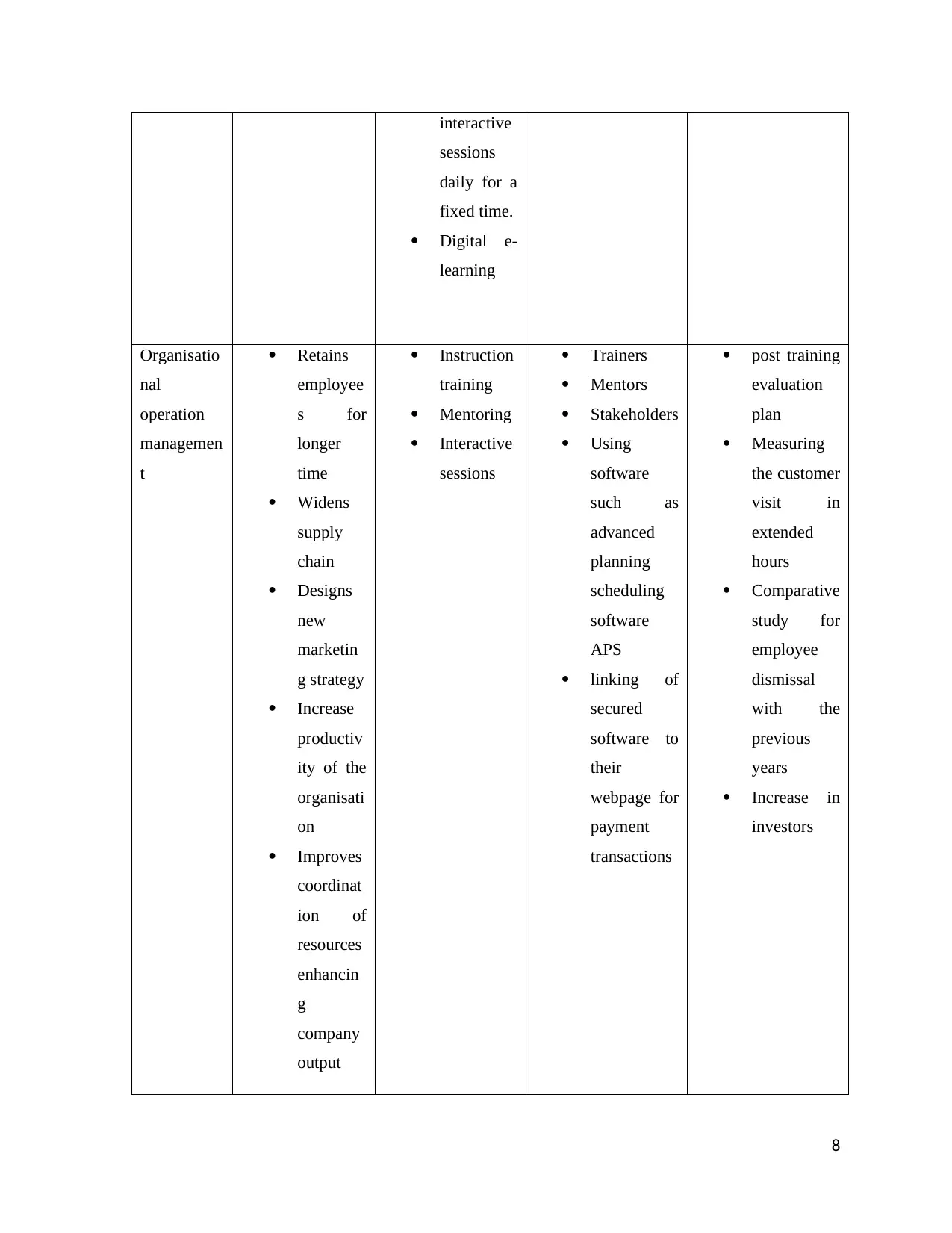
interactive
sessions
daily for a
fixed time.
Digital e-
learning
Organisatio
nal
operation
managemen
t
Retains
employee
s for
longer
time
Widens
supply
chain
Designs
new
marketin
g strategy
Increase
productiv
ity of the
organisati
on
Improves
coordinat
ion of
resources
enhancin
g
company
output
Instruction
training
Mentoring
Interactive
sessions
Trainers
Mentors
Stakeholders
Using
software
such as
advanced
planning
scheduling
software
APS
linking of
secured
software to
their
webpage for
payment
transactions
post training
evaluation
plan
Measuring
the customer
visit in
extended
hours
Comparative
study for
employee
dismissal
with the
previous
years
Increase in
investors
8
sessions
daily for a
fixed time.
Digital e-
learning
Organisatio
nal
operation
managemen
t
Retains
employee
s for
longer
time
Widens
supply
chain
Designs
new
marketin
g strategy
Increase
productiv
ity of the
organisati
on
Improves
coordinat
ion of
resources
enhancin
g
company
output
Instruction
training
Mentoring
Interactive
sessions
Trainers
Mentors
Stakeholders
Using
software
such as
advanced
planning
scheduling
software
APS
linking of
secured
software to
their
webpage for
payment
transactions
post training
evaluation
plan
Measuring
the customer
visit in
extended
hours
Comparative
study for
employee
dismissal
with the
previous
years
Increase in
investors
8
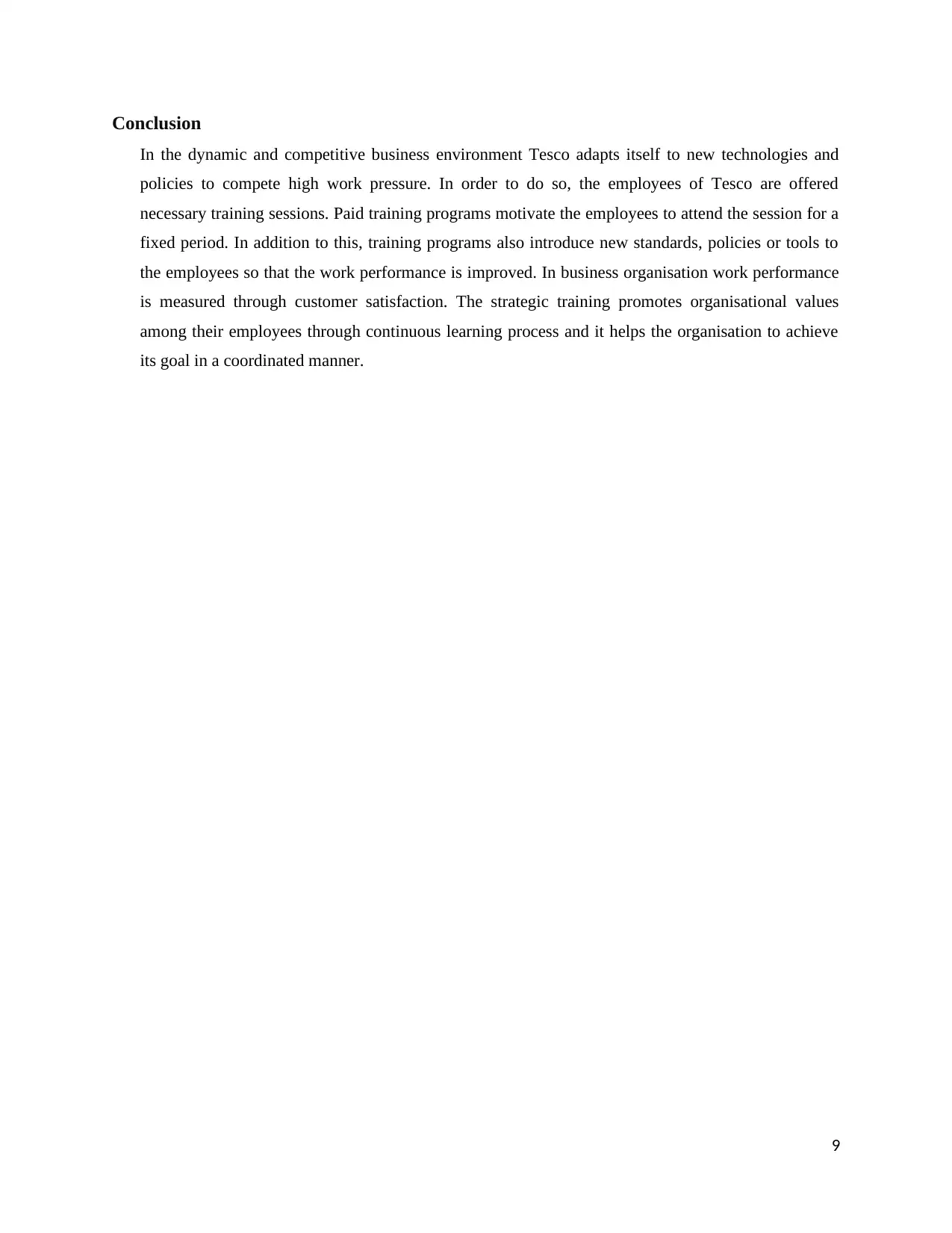
Conclusion
In the dynamic and competitive business environment Tesco adapts itself to new technologies and
policies to compete high work pressure. In order to do so, the employees of Tesco are offered
necessary training sessions. Paid training programs motivate the employees to attend the session for a
fixed period. In addition to this, training programs also introduce new standards, policies or tools to
the employees so that the work performance is improved. In business organisation work performance
is measured through customer satisfaction. The strategic training promotes organisational values
among their employees through continuous learning process and it helps the organisation to achieve
its goal in a coordinated manner.
9
In the dynamic and competitive business environment Tesco adapts itself to new technologies and
policies to compete high work pressure. In order to do so, the employees of Tesco are offered
necessary training sessions. Paid training programs motivate the employees to attend the session for a
fixed period. In addition to this, training programs also introduce new standards, policies or tools to
the employees so that the work performance is improved. In business organisation work performance
is measured through customer satisfaction. The strategic training promotes organisational values
among their employees through continuous learning process and it helps the organisation to achieve
its goal in a coordinated manner.
9
⊘ This is a preview!⊘
Do you want full access?
Subscribe today to unlock all pages.

Trusted by 1+ million students worldwide
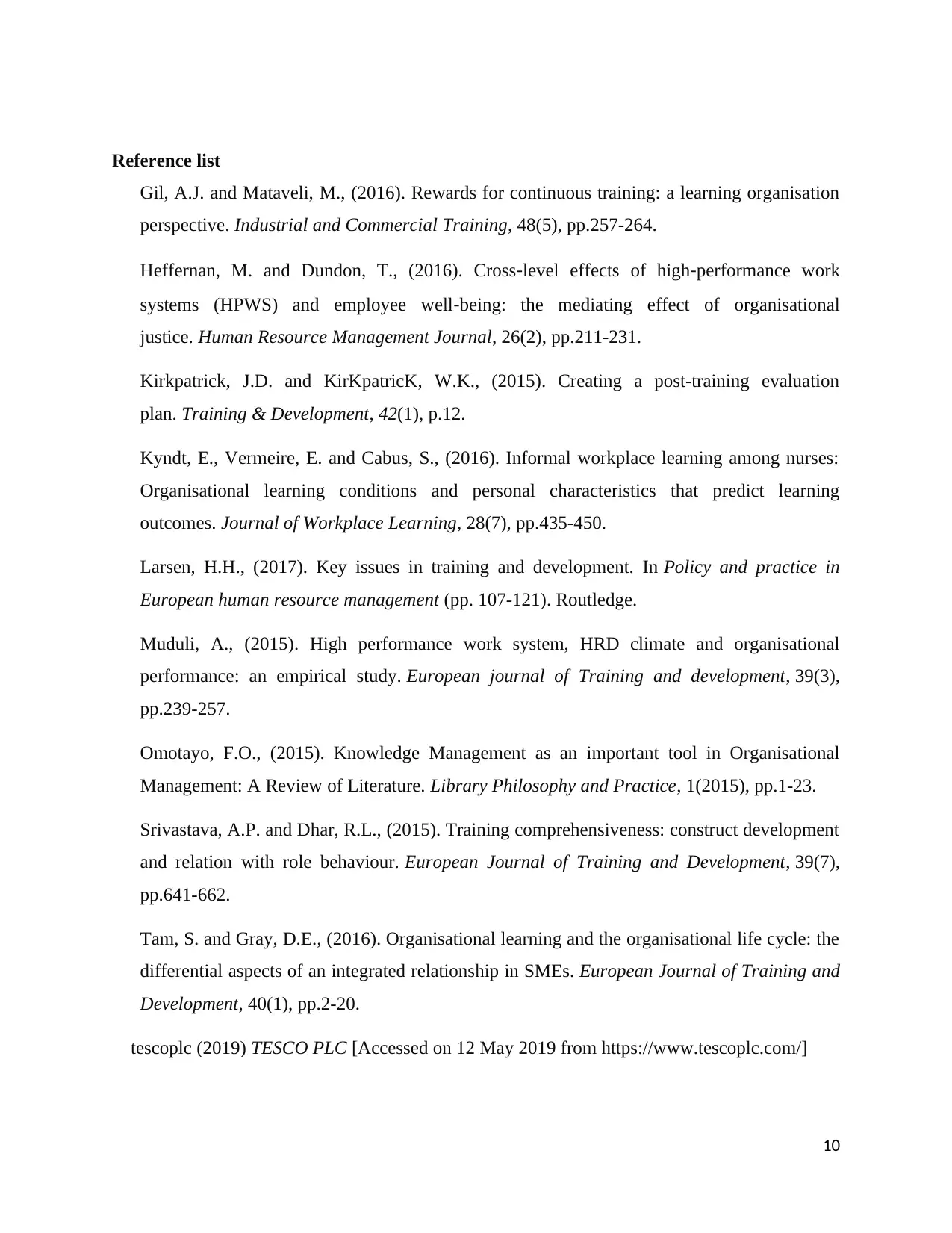
Reference list
Gil, A.J. and Mataveli, M., (2016). Rewards for continuous training: a learning organisation
perspective. Industrial and Commercial Training, 48(5), pp.257-264.
Heffernan, M. and Dundon, T., (2016). Cross‐level effects of high‐performance work
systems (HPWS) and employee well‐being: the mediating effect of organisational
justice. Human Resource Management Journal, 26(2), pp.211-231.
Kirkpatrick, J.D. and KirKpatricK, W.K., (2015). Creating a post-training evaluation
plan. Training & Development, 42(1), p.12.
Kyndt, E., Vermeire, E. and Cabus, S., (2016). Informal workplace learning among nurses:
Organisational learning conditions and personal characteristics that predict learning
outcomes. Journal of Workplace Learning, 28(7), pp.435-450.
Larsen, H.H., (2017). Key issues in training and development. In Policy and practice in
European human resource management (pp. 107-121). Routledge.
Muduli, A., (2015). High performance work system, HRD climate and organisational
performance: an empirical study. European journal of Training and development, 39(3),
pp.239-257.
Omotayo, F.O., (2015). Knowledge Management as an important tool in Organisational
Management: A Review of Literature. Library Philosophy and Practice, 1(2015), pp.1-23.
Srivastava, A.P. and Dhar, R.L., (2015). Training comprehensiveness: construct development
and relation with role behaviour. European Journal of Training and Development, 39(7),
pp.641-662.
Tam, S. and Gray, D.E., (2016). Organisational learning and the organisational life cycle: the
differential aspects of an integrated relationship in SMEs. European Journal of Training and
Development, 40(1), pp.2-20.
tescoplc (2019) TESCO PLC [Accessed on 12 May 2019 from https://www.tescoplc.com/]
10
Gil, A.J. and Mataveli, M., (2016). Rewards for continuous training: a learning organisation
perspective. Industrial and Commercial Training, 48(5), pp.257-264.
Heffernan, M. and Dundon, T., (2016). Cross‐level effects of high‐performance work
systems (HPWS) and employee well‐being: the mediating effect of organisational
justice. Human Resource Management Journal, 26(2), pp.211-231.
Kirkpatrick, J.D. and KirKpatricK, W.K., (2015). Creating a post-training evaluation
plan. Training & Development, 42(1), p.12.
Kyndt, E., Vermeire, E. and Cabus, S., (2016). Informal workplace learning among nurses:
Organisational learning conditions and personal characteristics that predict learning
outcomes. Journal of Workplace Learning, 28(7), pp.435-450.
Larsen, H.H., (2017). Key issues in training and development. In Policy and practice in
European human resource management (pp. 107-121). Routledge.
Muduli, A., (2015). High performance work system, HRD climate and organisational
performance: an empirical study. European journal of Training and development, 39(3),
pp.239-257.
Omotayo, F.O., (2015). Knowledge Management as an important tool in Organisational
Management: A Review of Literature. Library Philosophy and Practice, 1(2015), pp.1-23.
Srivastava, A.P. and Dhar, R.L., (2015). Training comprehensiveness: construct development
and relation with role behaviour. European Journal of Training and Development, 39(7),
pp.641-662.
Tam, S. and Gray, D.E., (2016). Organisational learning and the organisational life cycle: the
differential aspects of an integrated relationship in SMEs. European Journal of Training and
Development, 40(1), pp.2-20.
tescoplc (2019) TESCO PLC [Accessed on 12 May 2019 from https://www.tescoplc.com/]
10
1 out of 10
Related Documents
Your All-in-One AI-Powered Toolkit for Academic Success.
+13062052269
info@desklib.com
Available 24*7 on WhatsApp / Email
![[object Object]](/_next/static/media/star-bottom.7253800d.svg)
Unlock your academic potential
Copyright © 2020–2025 A2Z Services. All Rights Reserved. Developed and managed by ZUCOL.



